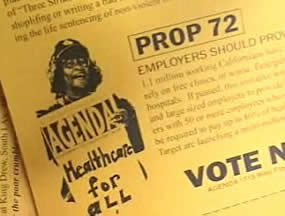 |
 |
 The primary means is through your voter registration and ID work, but don't forget the power of "buzz," that indefinable excitement and awareness of the campaign that is generated when voters see your signs around town.
The primary means is through your voter registration and ID work, but don't forget the power of "buzz," that indefinable excitement and awareness of the campaign that is generated when voters see your signs around town.
Finding the right level of effort to put into visibility work is one of the greatest challenges for any campaign field program; some work in this area is vital because it creates a “buzz” that feeds the rest of the program.When people see your signs, buttons or t-shirts, they are confirmed in their allegiance. (Keep in mind that visibility is mostly aimed at your existing supporters, not at the undecided.) They are more likely to remember to vote and to be willing to volunteer. But buzz is not quantifiable – you cannot easily measure whether the paraphernalia is helping you to achieve your goals – and there is a temptation to try to substitute “buzz” for concrete (and more difficult) voter ID and turn-out work. Moreover, of the signs that are distributed, few are put up, often less than 50 percent. Visibility work can become a sink for both money and time if it’s not approached with an awareness of its limitations and an eye on the bottom line.
The first question will be what kind to use. This depends on what others in the election are using and the constraints of your budget. Whatever you decide, familiarize yourself with local rules about putting them along roads and various properties, and whether you can be fined for doing it wrong or not removing them after the election.
How to distribute signs: Distributing signs is usually a piece of cake because yours supporters want and will gladly take signs (the challenge is to ensure that they’re actually put up). Some opportunities to distribute signs:
How to get the signs put up: You may be surprised to learn that this is the harder part. After you deliver signs, you might have a daytime volunteer call and inquire politely if they've been put up. If you’d like to get signs up in merchants’ windows, send a volunteer with tape to put them up. Ask people who come to the campaign office looking for signs to put their names and numbers on a list, which creates a small commitment to hang the thing. Bonus: you can call that person later to ask them to volunteer!
A few more things to think about:
In some respects, buttons are even better visibility than signs – they move around (though they also come off even more often than posted signs come down). Since buttons cost about $0.30 each and you can ask for a $1 donation for them, you should be able to break even on them. Field staff should give away buttons quite freely to any volunteers who are doing work; they are the ones most likely to wear them.
If you choose to make t-shirts, they should use the campaign’s logo and visual theme. Try to get volunteers to pay for them if you can – the goal is to not lose money on them!